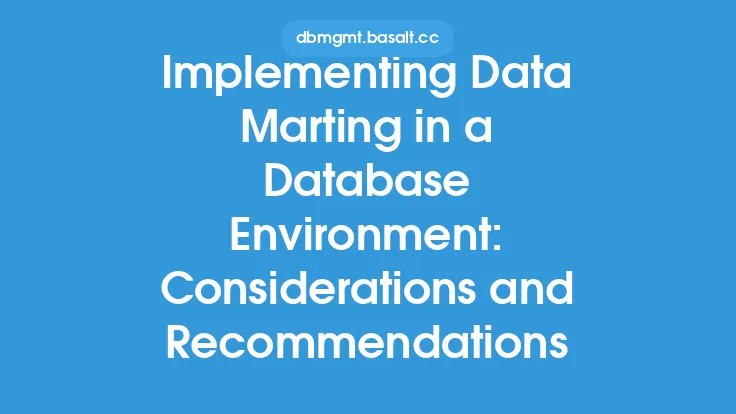When designing a database, one of the most critical aspects to consider is data security. This involves ensuring that the data stored in the database is protected from unauthorized access, use, disclosure, disruption, modification, or destruction. Data security is a crucial consideration in database design because it helps to prevent data breaches, which can have serious consequences, including financial losses, reputational damage, and legal liabilities. In this article, we will explore the key data security considerations in database design, including data encryption, access control, authentication, backup and recovery, and network security.
Introduction to Data Security in Database Design
Data security in database design involves a range of measures to protect the confidentiality, integrity, and availability of data. Confidentiality refers to the protection of data from unauthorized access, while integrity refers to the accuracy and completeness of data. Availability refers to the ability of authorized users to access data when needed. To achieve these goals, database designers must consider a range of security measures, including data encryption, access control, authentication, backup and recovery, and network security. These measures must be integrated into the database design from the outset, rather than being added as an afterthought.
Data Encryption in Database Design
Data encryption is a critical security measure in database design. It involves converting plaintext data into unreadable ciphertext to prevent unauthorized access. There are several types of encryption that can be used in database design, including symmetric key encryption, asymmetric key encryption, and hash functions. Symmetric key encryption uses the same key for both encryption and decryption, while asymmetric key encryption uses a pair of keys: a public key for encryption and a private key for decryption. Hash functions, on the other hand, use a one-way algorithm to transform data into a fixed-length string of characters. In database design, encryption can be applied at various levels, including column-level encryption, table-level encryption, and database-level encryption.
Access Control in Database Design
Access control is another critical security measure in database design. It involves controlling who can access the database and what actions they can perform. There are several types of access control that can be used in database design, including discretionary access control (DAC), mandatory access control (MAC), and role-based access control (RBAC). DAC involves granting access to users based on their identity, while MAC involves granting access based on the sensitivity of the data. RBAC, on the other hand, involves granting access based on the roles that users play within an organization. In database design, access control can be implemented using a range of mechanisms, including passwords, authentication tokens, and access control lists.
Authentication in Database Design
Authentication is the process of verifying the identity of users who attempt to access the database. It is a critical security measure in database design because it helps to prevent unauthorized access. There are several types of authentication that can be used in database design, including password-based authentication, token-based authentication, and biometric authentication. Password-based authentication involves verifying a user's password against a stored password, while token-based authentication involves verifying a user's authentication token against a stored token. Biometric authentication, on the other hand, involves verifying a user's biometric characteristics, such as fingerprints or facial features. In database design, authentication can be implemented using a range of mechanisms, including authentication protocols and authentication servers.
Backup and Recovery in Database Design
Backup and recovery are critical security measures in database design. They involve creating copies of the database and restoring them in the event of a failure or data loss. There are several types of backup that can be used in database design, including full backups, incremental backups, and differential backups. Full backups involve creating a complete copy of the database, while incremental backups involve creating a copy of the changes made since the last backup. Differential backups, on the other hand, involve creating a copy of the changes made since the last full backup. In database design, backup and recovery can be implemented using a range of mechanisms, including backup software and backup hardware.
Network Security in Database Design
Network security is a critical security measure in database design. It involves protecting the database from unauthorized access over the network. There are several types of network security that can be used in database design, including firewalls, intrusion detection systems, and virtual private networks. Firewalls involve blocking unauthorized access to the database, while intrusion detection systems involve detecting and preventing unauthorized access. Virtual private networks, on the other hand, involve creating a secure and encrypted connection between the database and remote users. In database design, network security can be implemented using a range of mechanisms, including network protocols and network devices.
Best Practices for Data Security in Database Design
To ensure the security of the database, there are several best practices that database designers should follow. These include encrypting sensitive data, implementing access control and authentication, backing up the database regularly, and protecting the database from network threats. Database designers should also ensure that the database is designed with security in mind from the outset, rather than adding security measures as an afterthought. Additionally, database designers should stay up-to-date with the latest security threats and vulnerabilities, and implement measures to mitigate them. By following these best practices, database designers can help to ensure the security and integrity of the database, and protect it from unauthorized access and other security threats.
Conclusion
In conclusion, data security is a critical consideration in database design. It involves ensuring that the data stored in the database is protected from unauthorized access, use, disclosure, disruption, modification, or destruction. To achieve this goal, database designers must consider a range of security measures, including data encryption, access control, authentication, backup and recovery, and network security. By integrating these security measures into the database design from the outset, database designers can help to ensure the security and integrity of the database, and protect it from unauthorized access and other security threats. Additionally, by following best practices for data security, database designers can help to ensure that the database is designed with security in mind, and that it is protected from the latest security threats and vulnerabilities.





